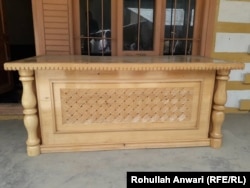PARUN, Afghanistan – With his chisel, 25-year-old Inyatullah is engrossed in carving Afghanistan’s national emblem into a square wooden board.
In his ramshackle shop in the remote provincial capital of eastern Nuristan Province, Inyatuallah, who goes by one name only, sees himself as the keeper of an ancient handicraft tradition.
He says he was attracted to woodcarving as opposed to his regular carpentry work that mainly involved making doors, window frames, and furniture.
“The traditional Nuristani woodcarving is a centuries-old tradition,” he told Radio Free Afghanistan. “We mostly work with just one chisel and use no machines.”
Sharafuddin, 67, is considered a master woodcarver in Parun. He specializes in carving intricate flowers and other traditional patterns into wooden artifacts and furniture.
“Woodwork has been our profession from the time that this place was called Kafiristan,” he said, referring to Nuristan’s name when it was called the “Land of Infidels” because most of the region’s inhabitants were pagans. The Hindu Kush region’s inhabitants converted to Islam in the late 19th century after an autocratic Afghan king ruled the vast forested region.
“We are happy to preserve this important tradition of our ancestors,” Sharafuddin said. “I am honored to make a living out of this important work.”
In pre-Islamic Nuristan, woodcarving held a symbolic significance, but the craftsmen came from Bari, a lower caste who were not considered members of Nuristan’s hierarchical society.
Today, the craft is a symbol of pride and guarantees a steady income in the remote region.
Mohammadullah, a local entrepreneur, employees a dozen people in his workshop. He says their commercial success required them to add Nuristani woodcarving to modern furniture pieces and extend to making emblems and other contemporary artifacts for profit.
“The government has helped us in establishing this business,” he said. “Our aim now is to take this craft to other places.”
Nuristan Governor Hafiz Abdul Qayyum says the government is interested in preserving and promoting traditional handicrafts.
“We aim to build a big workshop here through government funding,” he told Radio Free Afghanistan. “Our ultimate aim is to find a global market for our artisans.”
During a recent visit to Nuristan, Mujib Rahman Karimi, Afghanistan’s minister for rural rehabilitation and development, reiterated his government’s support for the craft.
“We want to help your industry by finding you new markets,” he told a group of carvers. “We would like to take your beautiful craft to other parts of Afghanistan and countries in the region.”
With abundant wood from its forests, carpentry and woodcarving flourished in Nuristan during most of the 20th century. The craft workers here made kitchenware and in addition to traditional furniture made doors, windows, and decorative artifacts. But the availability of relatively cheap plastic and metal utensils limited the utilitarian use of wooden products.
Nuristan’s artisans now hope that access to new markets will bring in more profit, and that the success of this cottage industry will entice new generations into learning the traditional craft.
Abubakar Siddique wrote this story based on Rohullah Anwari’s reporting from Parun, Afghanistan.








